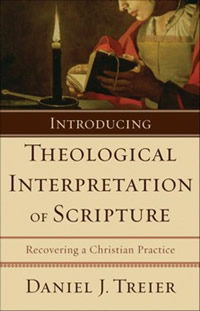Book Notes
 Daniel J. Treier, Introducing the Theological Interpretation of Scripture: Recovering a Christian Practice (Grand Rapids: Baker Academic, 2008), 221pp.
Daniel J. Treier, Introducing the Theological Interpretation of Scripture: Recovering a Christian Practice (Grand Rapids: Baker Academic, 2008), 221pp.
One of the continuities of the Christian church across the ages is the fact that it reads and seeks to understand its scriptures, the Bible. Amidst this continuity there is, of course, a great deal of diversity.
There is diversity across the traditions of Christianity. At the macro-level, there is diversity in the way each of the three major traditions of Christianity — Eastern Orthodoxy, Roman Catholicism, and Protestantism — approach the Bible, which diversity is further compounded among the many sub-traditions within each of these three, with Protestantism undoubtedly manifesting the greatest diversity. There is diversity across cultures, as Christians in different cultural settings inevitably read the Bible from within and with reference to that setting. There is diversity across the ages, when Christians in different historical periods (hence, different cultural contexts) read the scriptures in and, usually, in terms of, the period in which they live.
This being the case, those of us who are not specialists in the interpretation of the Bible can be thankful when scholars who are specialists write a well informed distillation and assessment of some contemporary addition to the seemingly ever-increasing diversity of proposals for reading Christian scripture. Daniel Treier, professor of theology at Wheaton College (Illinois), offers such a summary and assessment in Introducing Theological Interpretation of Scripture.
The "theological interpretation of Scripture" (TIS) seeks, in Treier’s words, to “reverse the dominance of historical criticism over churchly reading of the Bible and to redefine the role of hermeneutics [that is, the interpretation of the Bible] in theology” (p. 14). Several elements of this description are noteworthy. First, TIS seeks to overcome the almost exclusive dominance of “modern” (generally, 17th and 18th centuries onwards) over “pre-modern” (generally, 16th century and all the way back to early Christianity) principles and practices. Thus, at one level, TIS views the historical diversity referred to in the opening paragraph above as a resource, rather than only as out-dated habits to overcome.
Second, in looking back to earlier eras for potential inspiration and guidance, TIS seeks to restore “the church” to its rightful role in interpreting the Bible. And, this churchly mind set is not only a rationale for learning from the past, but it is also a principle which should inform reading the Bible in the present.
Third, in the contemporary context of specialization (some would say “extreme” specialization) among scholars of all disciplines — including biblical studies and theology — TIS wrestles with the relationship between responsible and competent interpretation of the Bible on the one hand (the primary concern of Biblical scholars), and biblical and thoughtful theology on the other (the primary concern of theological scholars). In the interest of full-disclosure, it should be noted that he comes to TIS primarily from his vocation as a theologian. However, he is well informed with regard to biblical studies, and this book, along with work by others in TIS, is a constructive contribution to encouraging more conversation between the disciplines of biblical studies and theology.
This reviewer is thankful for the emergence of TIS because of its readiness to overcome the tyranny of the present and to look to the past, including the ancient Christian past, for wisdom (one of his themes) in reading the Bible, and its desire to locate the reading of the Bible where it properly belongs — in the church.
Treier’s book may be more detailed and technical than some readers of Journey with Jesus may desire. For those, however, who are interested in staying current with contemporary approaches to interpreting the Bible, this book provides a substantive yet modest (less than 200 pages) introduction to an increasingly important approach.
W. David Buschart
Prof. of Theology and Historical Studies
Denver Seminary
Denver, Colorado


